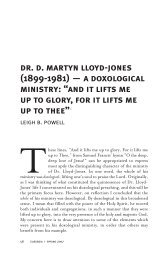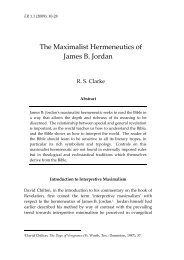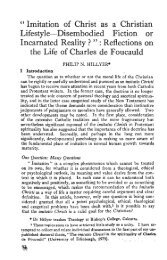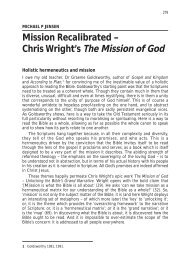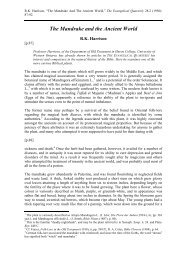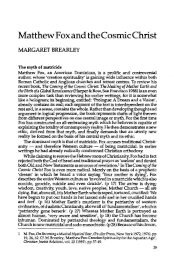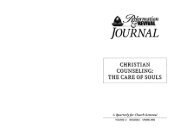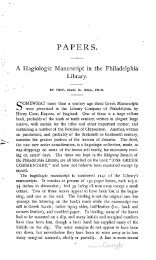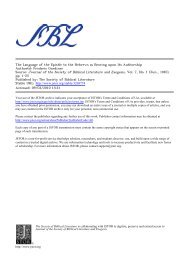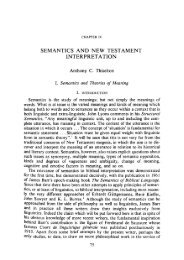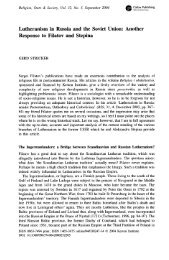Ancient Orient and Old Testament - BiblicalStudies.org.uk
Ancient Orient and Old Testament - BiblicalStudies.org.uk
Ancient Orient and Old Testament - BiblicalStudies.org.uk
You also want an ePaper? Increase the reach of your titles
YUMPU automatically turns print PDFs into web optimized ePapers that Google loves.
K.A. Kitchen, <strong>Ancient</strong> <strong>Orient</strong> <strong>and</strong> <strong>Old</strong> <strong>Testament</strong>. London: Inter-Varsity Press, 1966. Hbk. pp.191.<br />
fast-growing complexity of each section of <strong>Ancient</strong> <strong>Orient</strong>al studies (constantly fed by new data),<br />
accompanied by trends toward specialization. This change of emphasis in <strong>Ancient</strong> <strong>Orient</strong>al studies<br />
was partly responsible for two consequences first, that these studies could develop largely untouched<br />
by theological considerations <strong>and</strong> <strong>Old</strong> <strong>Testament</strong> controversies; 17 <strong>and</strong> secondly, that the impact of<br />
<strong>Ancient</strong> <strong>Orient</strong>al studies upon <strong>Old</strong> <strong>Testament</strong> studies was very small - largely limited to a h<strong>and</strong>ful of<br />
historical synchronisms <strong>and</strong> some obvious literary <strong>and</strong> other comparisons.<br />
<strong>Ancient</strong> Near Eastern studies have always been fed by a constant supply of new, tangible material.<br />
One illustration of this is the steady succession of discoveries of important cuneiform archives: the<br />
library of Assurbanipal <strong>and</strong> related Assyrian finds from 1850; the El Amarna tablets, 1887; the tablet<br />
collections from Nippur, I88g-I goo, whose Sumerian literary treasures are still being unlocked by S.<br />
N. Kramer <strong>and</strong> others; the Hittite archives from Boghaz-k6y since Igo6; more Assyrian records from<br />
Assur in Igo3-I4; the Nuzi tablets since the Ig2os; the brilliant discoveries at Ugarit since 1929 <strong>and</strong><br />
1948; the huge archives from Mari since 1936, etc. Other documentary finds (e.g., Egyptian) <strong>and</strong><br />
other aspects of Near Eastern discovery have been equally fruitful. Thus, in these disciplines, facts<br />
have a primary value <strong>and</strong> theories are mainly subordinated to them. The constant flow of new,<br />
objective material has repeatedly enforced the modification or even the wholesale replacement of<br />
theories, as in the ‘Hatshepsut problem’ in Egyptology. Kurt Sethe formulated a brilliant <strong>and</strong><br />
elaborate theory about the succession of certain monarchs of the Eighteenth Dynasty 18 - a theory<br />
which, in its heyday, won the assent of most Egyptologists. But a majority adhesion could not save<br />
even this ‘scientific’ theory from the fatal impact of a series of new facts (<strong>and</strong><br />
[p.23]<br />
re-examination of older ones), mainly provided by the American excavations at Deir el Bahri.<br />
Scholars in these fields have thus established their studies upon objective, verifiable fact <strong>and</strong> sound<br />
methodology, learnt the hard way, with an emphasis on external, first-h<strong>and</strong> data; a priori<br />
philosophical considerations have rarely been allowed to interfere directly.<br />
(c) Two Disciplines, One World<br />
A remarkable situation has thus come about. These two neighbouring fields of study have so far<br />
developed almost wholly independently of each other, <strong>and</strong> also along quite different lines: on the one<br />
h<strong>and</strong>, relatively objectively based disciplines of the <strong>Orient</strong>alists; on the other, idealistic theories of the<br />
<strong>Old</strong> <strong>Testament</strong> Scholars.<br />
This contrast is not unfair. For example, even the most ardent advocate of the documentary theory<br />
must admit that we have as yet no single scrap of external, objective (i.e., tangible) evidence for<br />
either the existence or the history of ‘J’, ‘E’, or any other alleged source-document. No manuscript of<br />
17 Apart from the Babel <strong>and</strong> Babel <strong>and</strong> Pan-Babylonian episodes; but these had little bearing on Assyriological<br />
progress.<br />
18 In his Untersuchungen z. Geschichte u. Altertumskmde Ägyptens, I, 1896, pp. 1-58, 65-129, <strong>and</strong> Das<br />
Hatschepsut-Problem, 1932, supported by J. H. Breasted in Untersuchungen..., 11 :2, 1900, pp. 27-55; for a<br />
thorough critical rebuttal based largely on the American results, see W. F. Edgerton, The Thutmosid Succession,<br />
1933.




